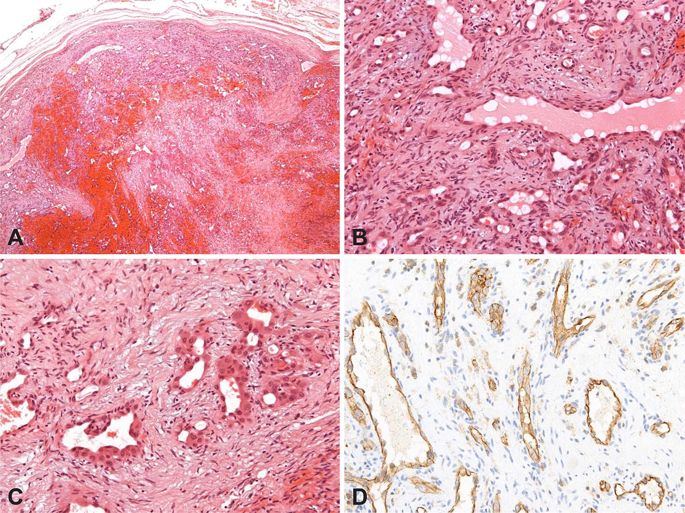Modern Pathology ( IF 7.5 ) Pub Date : 2020-02-24 , DOI: 10.1038/s41379-020-0505-4 Boštjan Luzar 1 , Eleni Ieremia 2 , Cristina R Antonescu 3 , Lei Zhang 3 , Eduardo Calonje 4

|
Pure intravascular growth of epithelioid hemangioma (EH) is exceptional. Herein, we report a series of 21 intravascular EHs, representing a potential serious diagnostic pitfall by mimicking malignant vascular neoplsms with epithelioid morphology. The tumors developed in 12 males and 4 females, aged from 11 to 71 years (mean age 40.2 years) with a predilection for the extremities (13 of 21, 61.9%), followed by the head and neck (8 of 21, 38.1%). Lesions ranged in size from 2 to 30 mm (mean size 13 mm). The most common presenting feature was a slowly growing nodule. Most neoplasms were solitary (13 of 16 patients, 81.2%) but three patients developed more than one intravascular EH (3 of 16, 18.8%). Treatment consisted of complete surgical excision and was generally curative. Follow-up was available for 13 lesions that had developed in ten patients (range 4–72 months, mean 27.3 months). No recurrences or development of additional tumors were observed. All 21 lesions developed in subcutaneous veins. Two morphological patterns of intravascular epithelioid endothelial cell proliferation were observed: (1) a lobular capillary hemangioma-like proliferation with variable formation of open vascular lumina and (2) a solid proliferation generally lacking open vascular spaces. A lobular capillary hemangioma-like pattern was the sole pattern in nine lesions, a mixed lobular hemangioma-like pattern, and solid pattern in eight and a pure solid pattern in four intravascular EHs. Mitotic activity in epithelioid endothelial cells ranged from 0 to 7 mitoses per 10 high-power field (mean 2.1 mitoses per 10 HPFs). Six lesions displayed brisk mitotic activity of five or more mitoses per 10 HPF (6 of 21, 28.5%). The number of mitoses was usually more prominent in areas with solid growth. Atypical mitoses were not observed. No intratumoral necroses were seen. Cytological atypia was mild (20 out of 21 cases). By immunohistochemistry, all tumors were positive for CD31 (14 out of 14) and ERG (5 out of 5). While all tested cases were FOS negative by immunohistochemistry (6 out of 6), one out of six cases (case 6) displayed FOSB nuclear positivity in about 30% of the lesional endothelial cells. Eight cases were analysed by FISH for the presence of FOS and FOSB gene rearrangements. While all cases were negative for FOSB rearrangements, a single case proved positive for FOS gene break-apart. In conclusion, intravascular growth of EH is not associated with adverse biological behavior. Solid intravascular proliferations of endothelial cells can mimic a malignant vascular tumor with epithelioid morphology. Nevertheless, intravascular EHs display mild cytological atypia coupled with low mitotic activity, and a lack of atypical mitoses, pronounced nuclear atypia, multilayering or tumor necrosis. Finally, the FOS gene is infrequently rearranged, and there are no FOSB gene abnormalities in this subset of EHs, suggesting a potential distinct pathogenesis than most classic EHs.
中文翻译:

皮肤血管内上皮样血管瘤。21例临床病理及分子学研究。
上皮样血管瘤 (EH) 的纯血管内生长是例外的。在此,我们报告了一系列 21 例血管内 EH,通过模拟具有上皮样形态的恶性血管瘤,代表了潜在的严重诊断缺陷。肿瘤发生于男性 12 例和女性 4 例,年龄从 11 岁到 71 岁(平均年龄 40.2 岁),好发于四肢(21 例中有 13 例,占 61.9%),其次是头颈部(21 例中有 8 例,占 38.1%) ). 病变的大小范围为 2 至 30 毫米(平均大小 13 毫米)。最常见的表现特征是缓慢生长的结节。大多数肿瘤是孤立的(16 名患者中的 13 名,81.2%),但 3 名患者发生不止一次血管内 EH(16 名患者中的 3 名,18.8%)。治疗包括完全手术切除并且通常是治愈性的。对 10 名患者(范围 4-72 个月,平均 27.3 个月)中出现的 13 个病变进行了随访。没有观察到其他肿瘤的复发或发展。所有 21 个病变都发生在皮下静脉中。观察到血管内上皮样内皮细胞增殖的两种形态学模式:(1) 小叶毛细血管瘤样增殖,伴有开放血管腔的可变形成;(2) 通常缺乏开放血管空间的实性增殖。小叶毛细血管瘤样模式是 9 个病变的唯一模式,混合小叶血管瘤样模式,8 个是实性模式,4 个血管内 EH 是纯实性模式。上皮样内皮细胞的有丝分裂活动范围为每 10 个高倍视野 0 到 7 个有丝分裂(平均每 10 个 HPF 有 2.1 个有丝分裂)。6 个病灶显示每 10 HPF 有 5 个或更多个有丝分裂的活跃有丝分裂活动(21 个中的 6 个,28.5%)。有丝分裂的数量通常在稳定生长的区域更为突出。未观察到非典型有丝分裂。未见瘤内坏死。细胞学异型性较轻(21 例中有 20 例)。通过免疫组织化学,所有肿瘤均为 CD31(14 个中的 14 个)和 ERG(5 个中的 5 个)阳性。虽然所有测试病例的免疫组化结果均为 FOS 阴性(6 例中的 6 例),但六分之一的病例(病例 6)在约 30% 的病变内皮细胞中显示出 FOSB 核阳性。FISH 分析了 8 个病例是否存在 未见瘤内坏死。细胞学异型性较轻(21 例中有 20 例)。通过免疫组织化学,所有肿瘤均为 CD31(14 个中的 14 个)和 ERG(5 个中的 5 个)阳性。虽然所有测试病例的免疫组化结果均为 FOS 阴性(6 例中的 6 例),但六分之一的病例(病例 6)在约 30% 的病变内皮细胞中显示出 FOSB 核阳性。FISH 分析了 8 个病例是否存在 未见瘤内坏死。细胞学异型性较轻(21 例中有 20 例)。通过免疫组织化学,所有肿瘤均为 CD31(14 个中的 14 个)和 ERG(5 个中的 5 个)阳性。虽然所有测试病例的免疫组化结果均为 FOS 阴性(6 例中的 6 例),但六分之一的病例(病例 6)在约 30% 的病变内皮细胞中显示出 FOSB 核阳性。FISH 分析了 8 个病例是否存在FOS和FOSB基因重排。虽然所有病例均对FOSB重排呈阴性,但一个病例证明对FOS基因断裂呈阳性。总之,EH 的血管内生长与不良生物学行为无关。内皮细胞的实体血管内增生可以模仿具有上皮样形态的恶性血管肿瘤。然而,血管内 EH 表现出轻度细胞学异型,伴有低有丝分裂活性,缺乏非典型有丝分裂,明显的核异型,多层或肿瘤坏死。最后,FOS基因很少重排,没有FOSB该 EH 亚群中的基因异常,提示与大多数经典 EH 不同的潜在发病机制。



























 京公网安备 11010802027423号
京公网安备 11010802027423号